Have to and have got to break all of the rules that pure modal auxiliary verbs follow. They consist of more than one word, they use infinitive forms of the main verbs, the auxiliary verb do is used for negatives and questions , and they conjugate for the third-person singular. Despite all of these differences, these semi-modal auxiliary verbs have several modal meanings. Modal auxiliary verbs, also commonly referred to as modal verbs or modals, are used to shift the meaning of the main verb in a clause.
These shifts include expressing possibility, ability, permission, obligation, or future intention. Students can find these confusing because one modal auxiliary verb can have multiple meanings depending on the context. The semi-modal auxiliary verb ought to ends in to, which makes the main verb an infinitive. This differs from pure-modal auxiliary verbs, which use the bare infinitive, the infinitive without to, for the main verb. The meaning of ought to is nearly the same as should in all cases.
When forming questions or negatives, should is more commonly used than ought to. Modals are those helping verbs that express the mode of action denoted by the main verb. These modals are used to express ability, power, permission, request, possibilities, willingness, etc. They have a special place in the English language as they perform certain structural function in sentence formation. In this unit you will see how we can form sentences to communicative various language functions using them. You will realize that composing sentences using tenses is not enough and all things cannot be expressed using tenses, all language functions cannot be done using only tenses.
Modal Auxiliaries help us in doing functions like warning some one, making suggestions, giving advice, threatening others, talking about memories, etc. Good understanding of these modal auxiliaries is necessary to form various sentences. As usual like tenses we shall study them as 'structure words' for sentence formation for various language functions. Semi-modal auxiliary verbs, often simply called semi-modal verbs, are verbs that sometimes behave like modal auxiliary verbs.
(They are also sometimes known as marginal modal verbs.) Like the "proper" modal verbs, they are used with the base form of verbs to create a unique meaning. The modal auxiliary verbs are never used as a main verb. In addition, they do not have the five forms that main verbs have. While other auxiliary verbs can be used as a main verb and have the five forms, these modal auxiliary verbs do not. In English, modal verbsare a small class of auxiliary verbs used to express ability, permission, obligation, prohibition, probability, possibility, advice.
You may also find modal verbs referred to as "auxiliary verbs". This is because they help the main verb by adding extra information about it to the sentence. The information it adds lets the listener know things like our intentions, the likelihood of an event, or if they are capable of or allowed to do something. When used with the main verb, modal verbs do not end with -s for the third-person singular. Modal auxiliary verbs never change form, but they have a different form for past tense.
Is a semi-modal verb because it can function as a modal verb and can also act as a main verb. A greater variety of double modals appears in some regional dialects. In English, for example, phrases such as would dare to, may be able to or should have to are sometimes used in conversation and are grammatically correct. The double modal may sometimes be in the future tense, as in "I will ought to go," where will is the main verb and ought to is also an auxiliary but an infinitive.
Another example is We must be able to work with must being the main auxiliary and be able to as the infinitive. Other examples include You may not dare to run or I would need to have help. The negated forms are will not (often contracted to won't) and would not (often contracted to wouldn't). For contracted forms of will and would themselves, see § Contractions and reduced pronunciation above.
The English modal verbs are a subset of the English auxiliary verbs used mostly to express modality (properties such as possibility, obligation, etc.). They can be distinguished from other verbs by their defectiveness and by their neutralization (that they do not take the ending -s in the third-person singular). Have to is often grouped with modal auxiliary verbs for convenience, but in fact it is not a modal verb. In the have to structure, "have" is a main verb.
To make an interrogative sentence , the modal auxiliary verb is inverted with the subject. No other auxiliary verbs are added to make questions. As you read, underline all modal adverbs and circle all modal verbs.
Above each modal verb indicate what ''type'' of modal verb it is (i.e. possibility, obligation, advice, permission, or ability). The modal auxiliary verbs are auxiliary verbs that specifically affect the mood of the verb. Remember that verb mood is about the attitude in which the action or state is expressed-as a statement of fact or opinion, as a wish, as a possibility, or as a command. All of these modal verbs must come before a verb to help express at least one of the modality examples listed above. In some cases, though they can be used to express more than one modality, but you'll see more on that in the following section. So, let's take a look at some example sentences and highlight how the modal verb is expressing modality and adding more information to the verbs that follow them.
The verbs dare and need can be used both as modals and as ordinary conjugated (non-modal) verbs. As non-modal verbs they can take a to-infinitive as their complement (I dared to answer her; He needs to clean that), although dare may also take a bare infinitive (He didn't dare go). In their uses as modals they govern a bare infinitive, and are usually restricted to questions and negative sentences. Ought is used with meanings similar to those of should expressing expectation or requirement. The principal grammatical difference is that ought is used with the to-infinitive rather than the bare infinitive, hence we should go is equivalent to we ought to go. Because of this difference of syntax, ought is sometimes excluded from the class of modal verbs, or is classed as a semi-modal.
Note that the preterite forms are not necessarily used to refer to past time, and in some cases, they are near-synonyms to the present forms. Note that most of these so-called preterite forms are most often used in the subjunctive mood in the present tense. The auxiliary verbs may and let are also used often in the subjunctive mood.
Famous examples of these are "May The Force be with you." and "Let God bless you with good." These are both sentences that express some uncertainty; hence they are subjunctive sentences. Modal verbs indicate possibility, obligation or ability. Find out how your child will be taught about modal verbs in grammar lessons in KS2 and the kinds of activities they might be asked to complete in the primary-school classroom. These verbs are all modal verbs, which means that they are generally used in combination with other verbs, and are used to change the verb's meaning to something different from simple fact.
Modals express possibility, ability, prediction, permission, and necessity. Had better is a two-word semi-modal auxiliary verb that has the same characteristics as pure modal auxiliary verbs. Let's take a look at ought to, had better, have to, be able to, used to, and be supposed to. We'll explain some of the reasons why these are not always categorized as modal auxiliary verbs. You'll also see some examples demonstrating their modality. Modal adverbs are used to modify specific verbs that consist of a linking verb and sometimes another verb.
Examples of modal verbs include can, could, may, might, must, shall, should, will and would. Adverbs that modify these verbs say something about possibility, obligation, and emphasis. Remember that modal adverbs cannot be negated, and they are not used in questions.
Dare and need are considered semi-modal because they can also function as main verbs, able to take nouns and infinitives as objects and to conjugate for person, tense, and number. "Ought" is probably the simplest of this set of modal verbs. It's almost always followed by "to" and the infinitive form of a verb.
It means the same thing as "should," and is used in the same ways, although "ought" is less common and a bit more formal. A few examples of "ought" are "We ought to be home by noon," which means "I expect that we will be home by noon," and "I ought to fix that," which means "I should fix that." Will is becoming much more common than shall, and this trend seems to be continuing.
The next two tables illustrate some of the similarities and differences between these two modal auxiliary verbs. Modal auxiliary verbs are followed by a main verb in its bare infinitive form . The nine pure modal auxiliary verbs, will, shall, can, could, may, might, must, would, and should, share the same characteristics. Many sources and student textbooks do not differentiate between pure modal auxiliary verbs and semi-modal auxiliary verbs, and others separate them completely. Definitions of modal verbs and modal adverbs are included, and answers are provided.
There's also a space for children to write a couple of sentences in the same style using modal verbs and modal adverbs. To form questions the subject and the first verb are swapped if the verb requires no do-support such as Will you be able to write? If the main auxiliary requires do-support, the appropriate form of to do is added to the beginning, as in Did he use to need to fight? In formal standard English usage, more than one modal verb is not used consecutively, as modals are followed by a base verb, which they themselves lack. They can be combined only with non-modal constructions that have a modal function, such as have to, which in spite of its function is not a modal verb. Thus, might have to is acceptable, but might must is not, even though must and have to can normally be used interchangeably.
However the main auxiliary , does not have to be in the infinitive. To put double modals in past tense, only the first modal is changed as in I could ought to. Double modals are also referred to as multiple modals. Modal adverbs are adverbs of emphasis that sometimes accompany modal verb forms.
In this lesson, we'll talk about what these adverbs do and how they work in expressing meaning in language. The modal 'can' is a commonly used modal verb in English. It is used to express; ability, opportunity, a request, to grant permission, to show possibility or impossibility. It is this large amount of functions and the fact that 'can' is replaced by other modals when it is used to express future or past time that often lead to certain errors. Read the following examples and explanations carefully. In many languages, the third person is used even when talking to an individual as a sign of respect and formality.
In the English, however, we don't have such a luxury and resort to voice inflection and modal verbs to show politeness or respect to someone unknown to us or someone older than ourselves. They facilitate the main verb for suggesting potential, expectation, permission, ability, possibility, and obligation. The nine main modal verbs express a range of meanings, which may differ very subtly. The main meanings, especially those used in formal English, will be summarised here. Auxiliary verbs add grammatical or functional meaning to the clauses in which they are used.
They can be used to express aspect, voice, modality, tense, etc. For example, I have read this book so many times. "Have" is an auxiliary, which helps express the perfect aspect. There are certain rules which surround the use of modal verbs, for example the word 'to' must never be used after a modal verb. Learning these rules and how a modal verb can function within a sentence can greatly help you in forming grammatically correct sentences.
With modal verbs, use the infinitive form of the main verb without "to". To talk about past habits or conditions that are no longer true in the present, we use the semi-modal auxiliary verb used to. The past form of the auxiliary verb do is used when forming negatives and interrogatives. Be going to is a semi-modal auxiliary verb that has two basic meanings.
The first meaning describes plans, intentions, or decisions for the future. We also use be going to for predictions when we are 99.9% sure about the future based on present facts. The adverb not is used with the modal auxiliary verb to create negative sentences. Each video comes with interactive captions—click any word for an instant definition and pronunciation.
FluentU will also show you other videos that have the verb so you can learn how to use it in any context. It's a great way to absorb the different uses of English modal verbs, which can get confusing. And you'll be actively building your English vocabulary at the same time. I'll discuss what each one means and how to use them below. I'll add examples, and as you read through them I encourage you to try to find more examples of each. Once you understand how modal verbs work it'll help you speak English conversationallyas well asin an academic setting.
Learn modal verb definition and how to use modal verbs in English with useful grammar rules, ESL infographic and example sentences. There is another famous song that has a modal verb of advice in its title. The song, by Canadian singer Alanis Morissette, was very popular in 1995. The most famous part of the chorus is when she says You oughta know. Is the most common modal verb of advice in English. We can use it in positive and negative sentences as well as in questions.
Take a look at the table below to see how to use this verb. See Palmer, F. R., Mood and Modality, Cambridge Univ. Press, second edition, 2001, p. 33, and A Linguistic Study of the English Verb, Longmans, 1965. For an author who rejects ought as a modal because of the following particle to , see Warner, Anthony R., English Auxiliaries, Cambridge Univ. For more examples of discrepancies between different authors' listings of modal or auxiliary verbs in English, see English auxiliaries. Often 'could' can be used to replace can to express modality in a slightly different way.
what are modals give five examples
Look at the first example for can again – if you changed 'I can run' to 'I could run' you are still expressing ability, but you are now expressing past ability instead. Try replacing could in the other two sentences too. Most people will see the word verb and think "doing words" because verbs are simply action words that show something happening in some way.
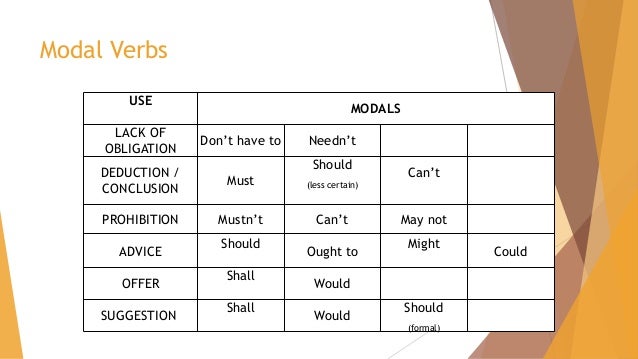
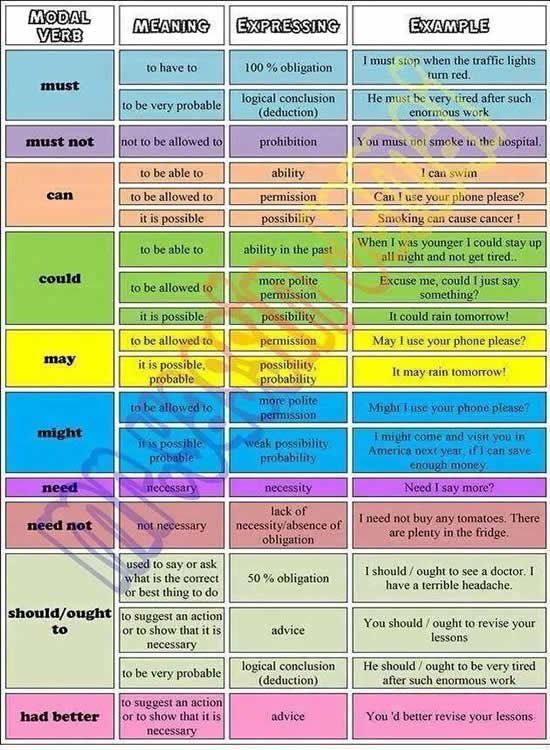



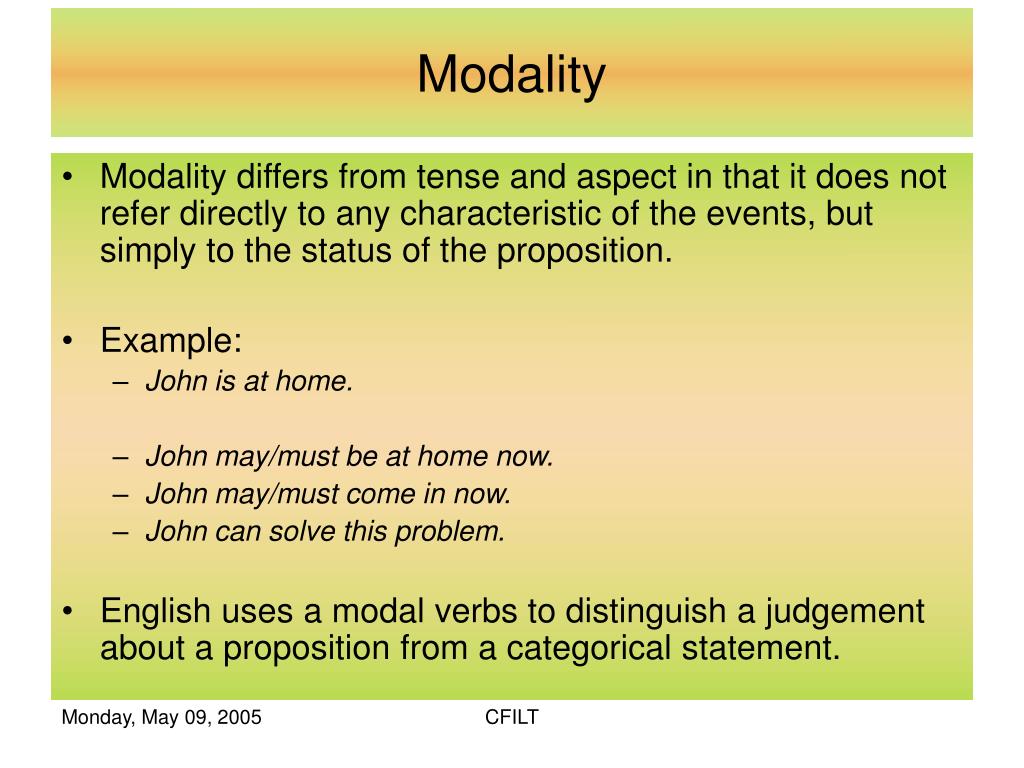


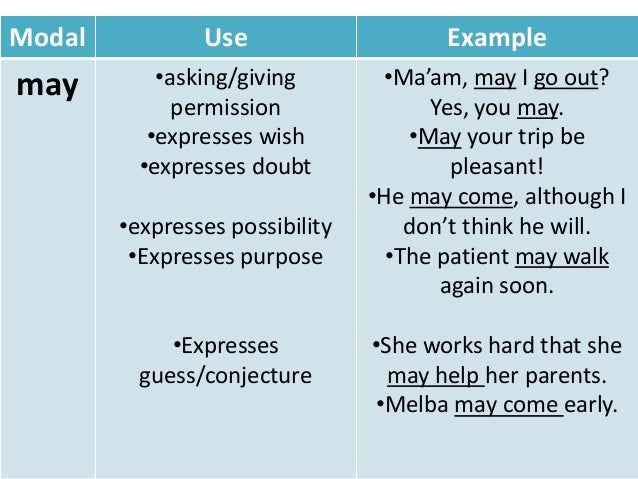


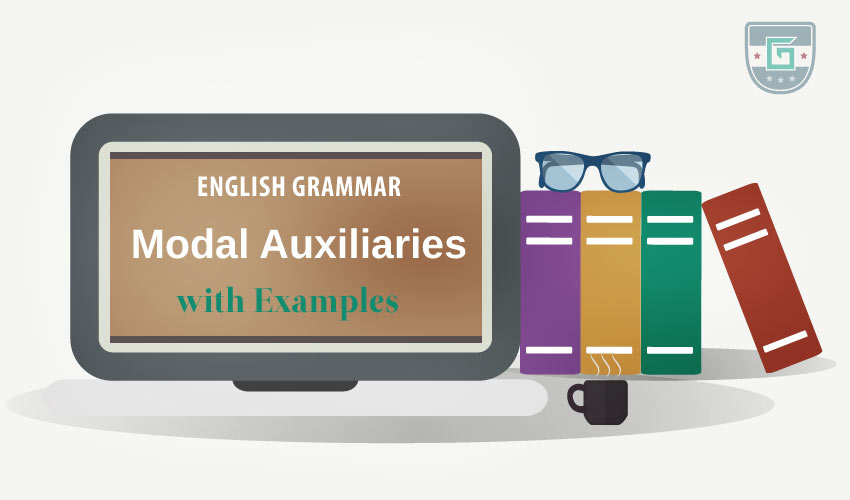
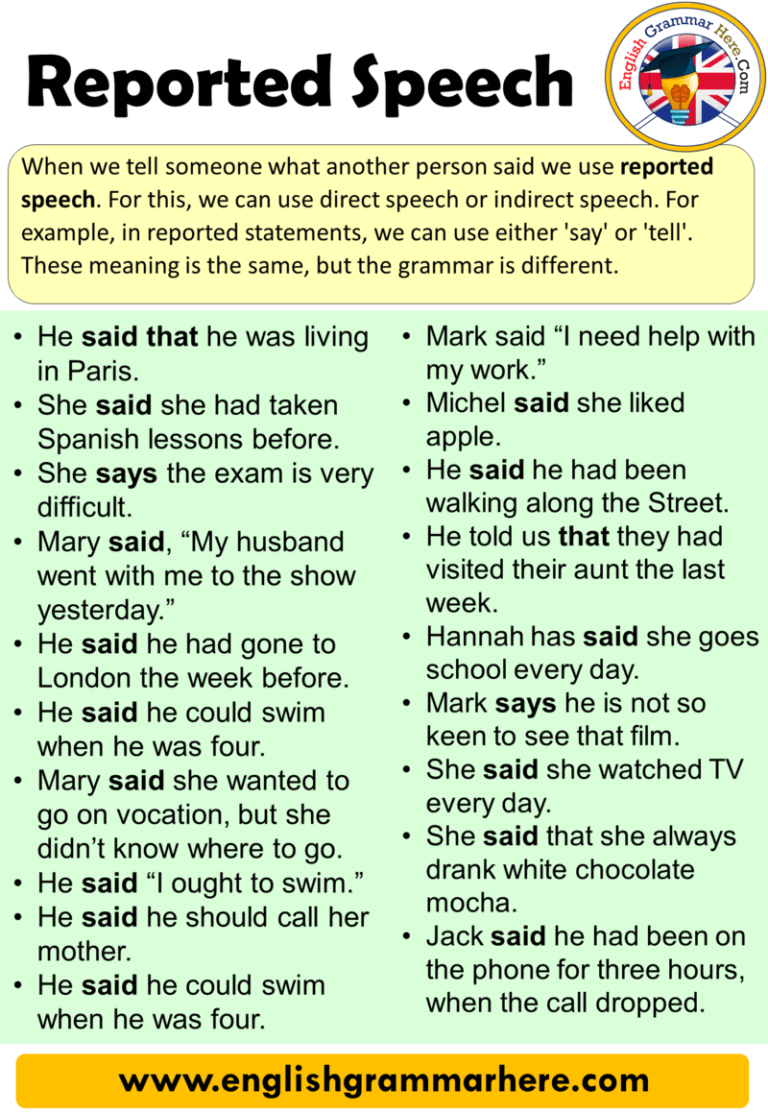


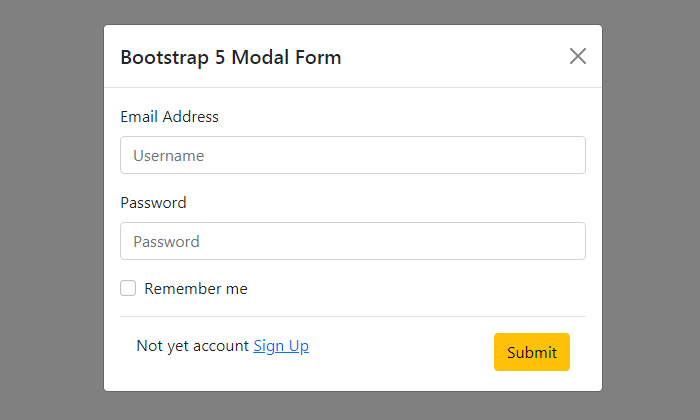







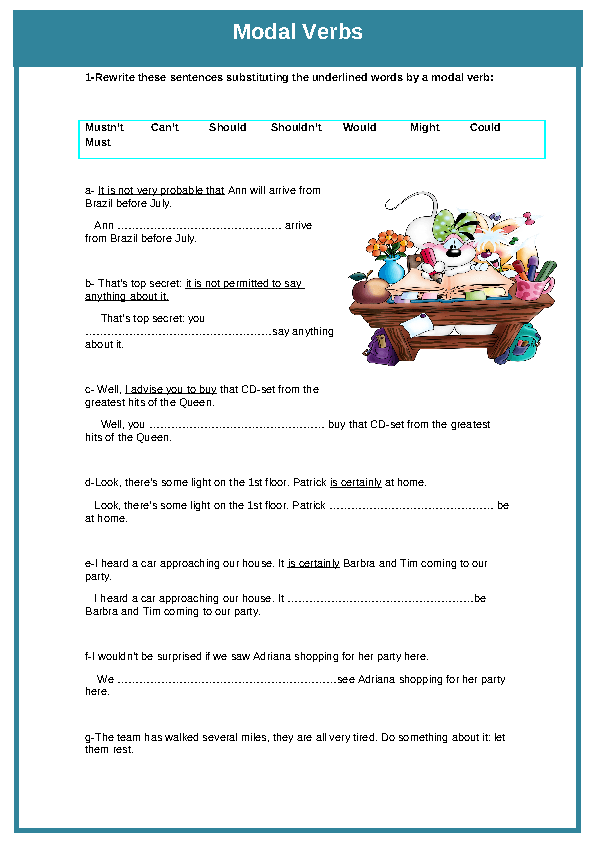
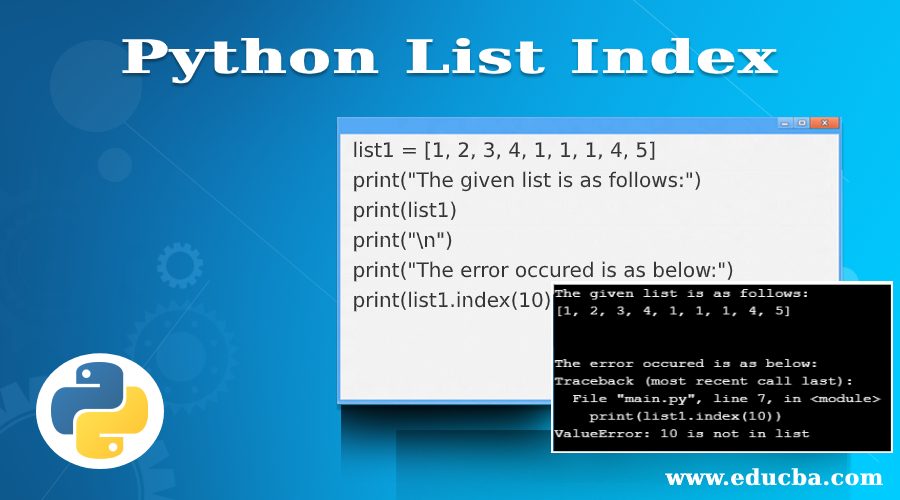
No comments:
Post a Comment
Note: Only a member of this blog may post a comment.